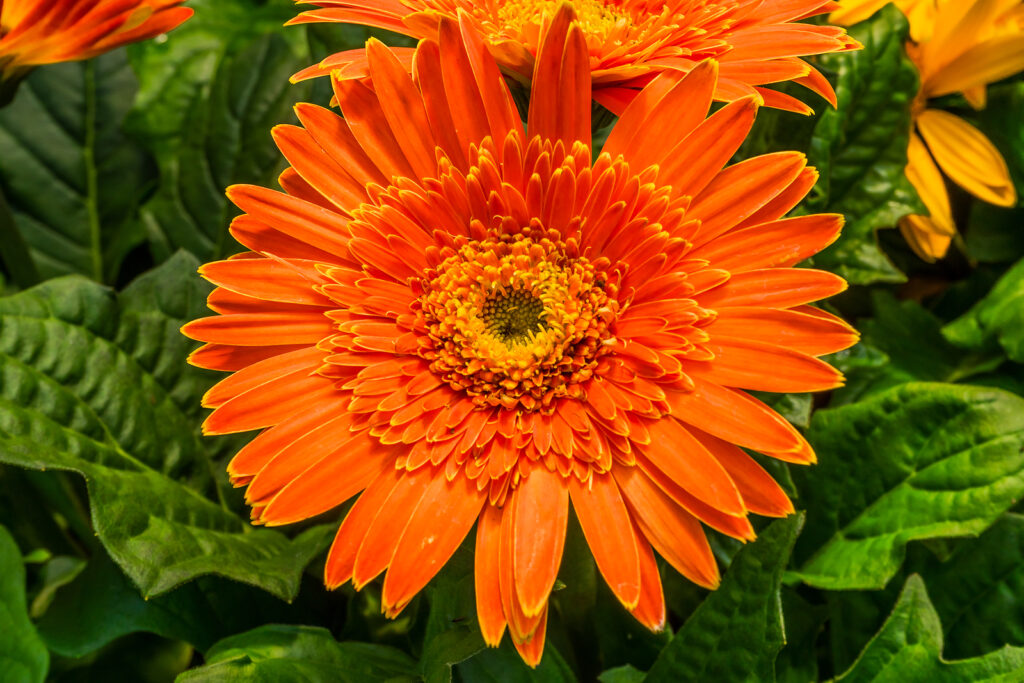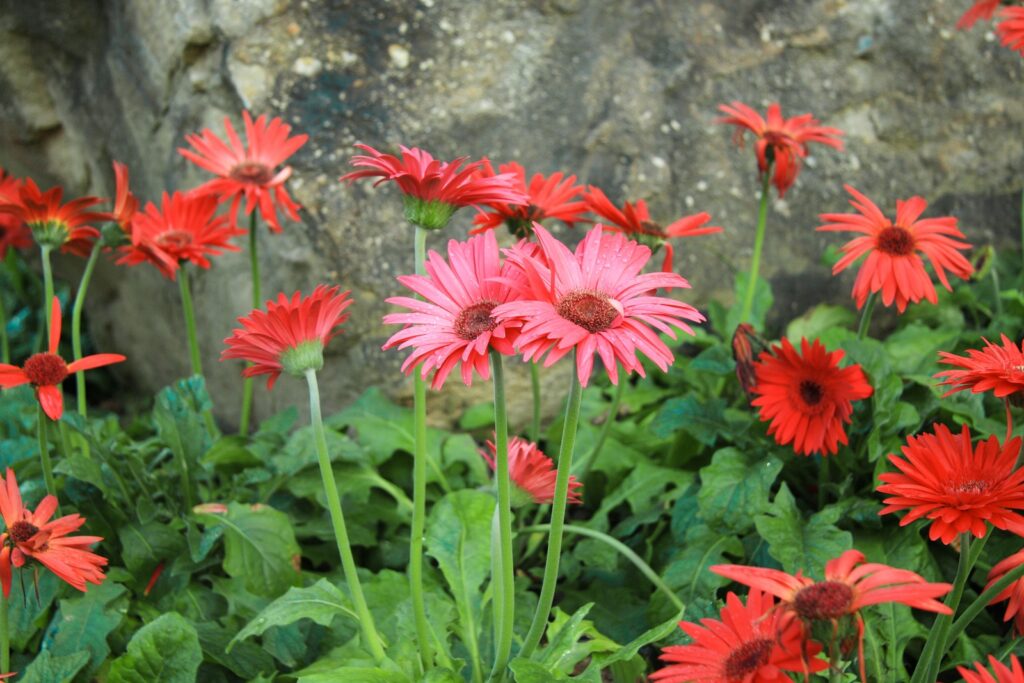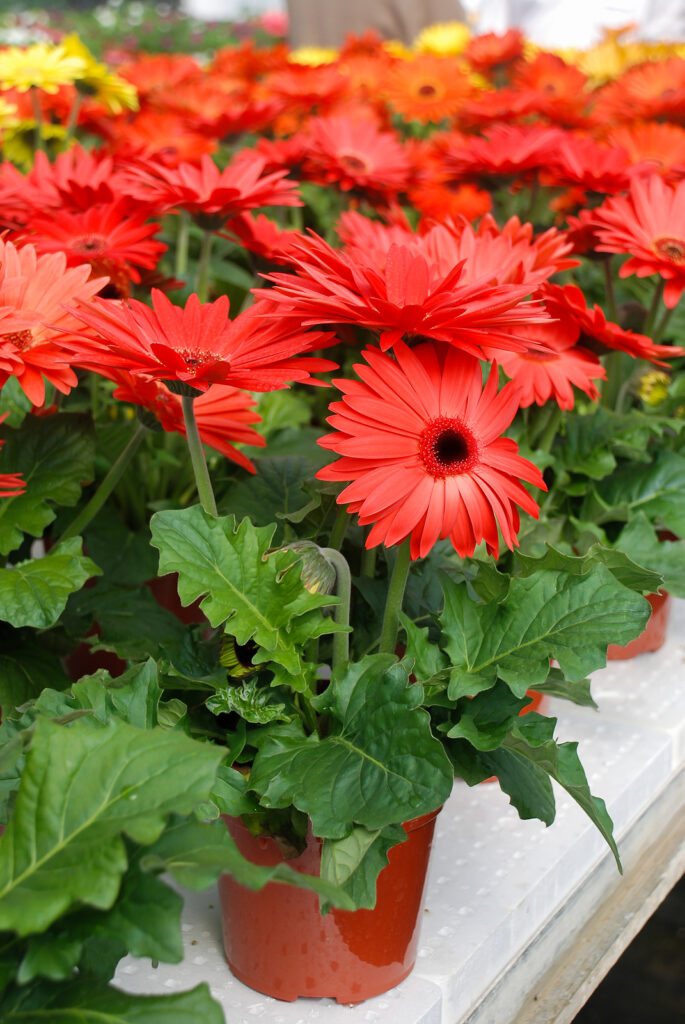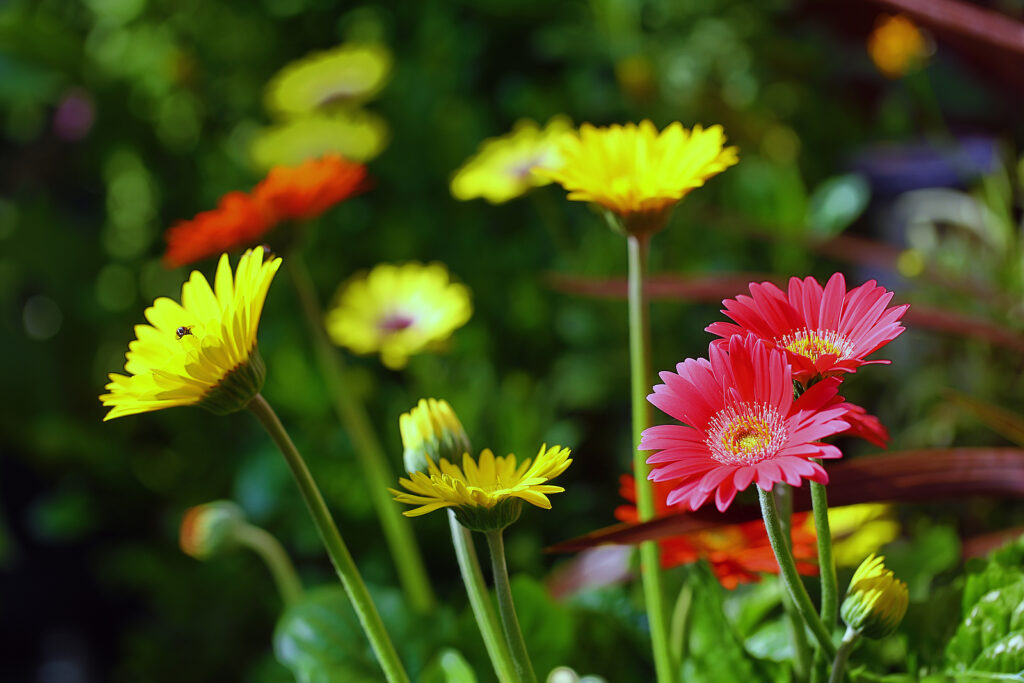The Transvaal daisy, Gerbera, is a perennial often grown as an annual. It has lobed green leaves and tall stems of daisy-like, summer flowers in a broad range of colors–white, cream, yellow, orange, peach, pink, red, or white with yellow discs.
Gerbera daisies are deeply rooted and withstand heat and pests. Flowers bloom for most of the year in warm climates; they can be grown year-round indoors.
In warm climates, gerberas can live and thrive for many years. Individual blossoms last about two weeks.
There are about 40 species of Gerbera, but only one Gerbera jamesonii is commonly grown in gardens.
Use gerberas in beds and borders and as edging plants. Grow them in containers. They make long-lasting cut flowers.

Get to know Gerbera–Transvaal Daisy
- Plant type: Tender perennial commonly grown as an annual
- Growing Zones and range: Zones 7 to 10; grow as cool-season annual in Zones 3-6; grow as a perennial in Zones 7-10; grow without protection in Zones9-11.
- Hardiness: Hardy to 15°F (-9°C); tender; withstands heat, killed by a hard frost
- Height and width: 8 to 24 inches (20-61cm) tall; 6 to 20 inches (15-50cm) wide
- Flowers: Daisylike flowers with slender ray petals 3 inches (7.6cm) wide or more; flowers can be single, double, crested, and quilled
- Flower colors: Intense reds, yellows, peaches, pinks, creams
- Bloom time: Midsummer through fall; blooms all year in Zones 9-11
- Uses: Mixed flower or shrub border, beds, containers, cutting garden
- Common name: Gerbera, Transvaal daisy
- Botanical name: Gerbera spp.
- Family: Asteraceae
- Origin: Native from Africa to Asia to Indonesia
Where to plant Gerbera
- Grow gerbera in full sun in Zones 3-6; grow in part afternoon shade in Zones 7-10.
- Plant gerbera in humus-rich, well-drained, slightly sandy soil. Plants will die quickly in poorly drained or soggy soils.
- Gerberas want a soil pH of 6.5 to 7.5.
Gerbera uses and companions
- Plant Gerberas where they can be readily seen; near a doorway or in a container on a patio/
- Gerberas are handsome at the front of a border.
- Gerberas are very good cut flowers.
- Good garden companions for Gerbera include Achillea, Coreopsis, Oenothera, Perovskia, Salvia, Senecio, Sysyrinchium striatum.

When to plant Gerbera
- Set established gerbera plants in the garden in early spring in Zones 3-6; set out plants in spring or fall in Zones 8-10. Gerberas grow best in warm weather.
- Start seedlings indoors as early as 10 weeks before the last frost in spring.
- Sow seed outdoors after the last spring frost when the weather has warmed.
- Set seedlings in the garden in spring after the danger of frost has passed.
Planting and spacing Gerbera
- Start seed indoors, one seed per pot, in small pots; cover the seed with less than 1/8 inch of soil.
- Keep containers at 70°F (21°C) under bright artificial light until seeds germinate in about 7 days.
- Give seedlings started indoors 12 hours of artificial light each day.
- When leaves are 2 inches (5cm) long move plants outdoors if the weather is warm or pot up until the weather warms.
- Space gerberas 8 to 20 inches (20-50cm) apart.

How to water and feed Gerbera
- Keep the soil evenly moist but not wet for the best growth; water when the soil starts to dry or plants wilt during hot weather.
- Fertilize gerbera occasionally, every 6 weeks, or work in a 9-month slow-release fertilizer in spring.
Gerbera care
- Mulch around gerberas with aged compost to conserve soil moisture.
- Trim spent blooms often to promote flowering.
- Protect plants in winter by mulching around crowns with aged compost or chopped leaves.
- Grow gerberas as an annual or dig up plants each fall and grow them indoors through winter in a well-lit area.
- Gerberas are deep-rooted and do not like being transplanted.
- When cutting flowers for arrangements, slit the bottom inch of the stem before placing it in water.
Growing Gerbera as a houseplant
- Gerbera jamesonii can be grown as a houseplant.
- Gerbera grows well in a wide range of temperatures but needs direct light.
- Grow Gerbera in a rich, soulless, well-drained medium.
- The medium should be kept evenly moist when the plant is growing or flowering, and allowed to dry slightly between waterings at other times.
- Fertilize Gerbera monthly during spring and summer.

Gerbera pests and diseases
- Gerberas are prone to gray mold and mildew.
- Gerbera can be attacked by aphids, mealybugs, whiteflies, thrips, spider mites, and leaf miners.
Gerbera propagation
- Divide established plants that have crowded crowns in warm weather; dig deeply to avoid harming the central taproot of each plant.
- Grow Transvaal daisy from cuttings taken from the base of the plant in summer.
- Propagation by seed is the most common.
- Gerbera seed germination takes 4 to 6 weeks at 70° to 75°F (21°-24°C).
Gerbera varieties to grow
- Gerbera jamesonii, Transvaal daisy, Baberton daisy: Tender perennial grows 12 to 18 inches (30-45cm) tall with deeply lobed leaves that are woolly underneath; bears 3 to 5 inch single or semi-double daisylike flowers carried on leafless stems from early to late summer; flowers in shades of orange-red, orange, red, yellow, pink, or cream; cultivars include easy to grow ‘Rainbow’, ‘California Giants’ that grows to 24 inches (58cm) tall, and ‘Skipper’ is a compact variety that grows to 8 inches (20cm) tall.
Gerbera Daisy frequently asked questions
Q: When do Gerbera daisies bloom?
A: The main blooming period extends from early spring to fall, but with proper conditions, blooms can appear throughout the winter.
Q: How can I grow Gerbera daisies indoors?
A: Giver Gerbera daisies bright light or filtered sun from an eastern or western exposure. Let the soil dry slightly between waterings. Mist the leaves occasionally. The temperature should not exceed 65°F during the day and about 55° to 60°F at night. They may not do well at ordinary room temperature. Feed plants every two weeks with a dilute organic fertilizer formulated for indoor plants. Remove faded flowers right away.
Q: When should I repot my Gerbera daisy?
A: Pot-on Gerbera daisies in spring before buds form. Pot-on when the plant completely overcrowds its pot space.
Q: I planted a Gerbera I bought at a garden center, but it did not grow. What did I do wrong?
A: If you have kept the soil just moist and did not overwater, it’s possible you set the plant too deep. Be sure the crown (the point where the stem and root merge)is not planted below the soil level



